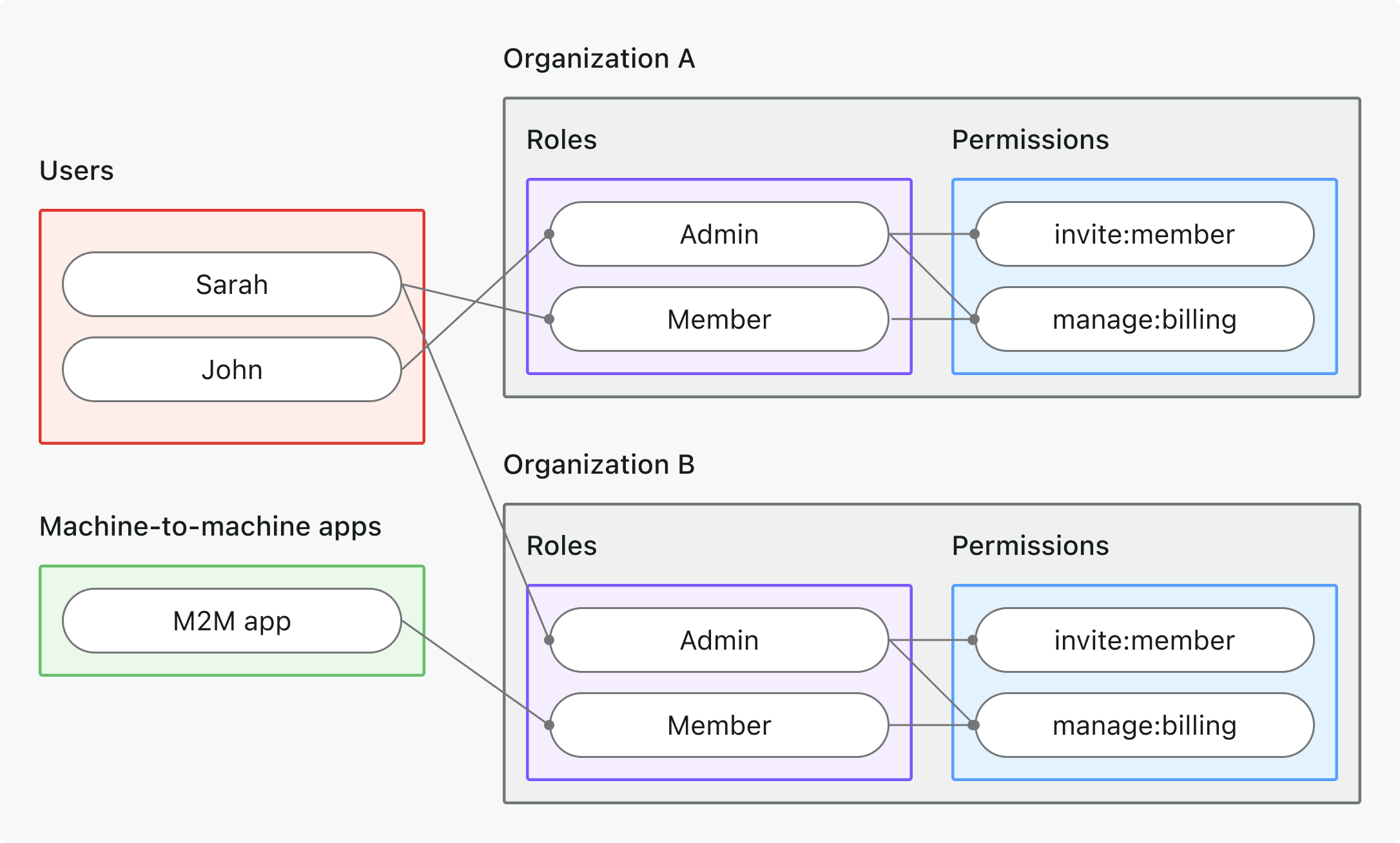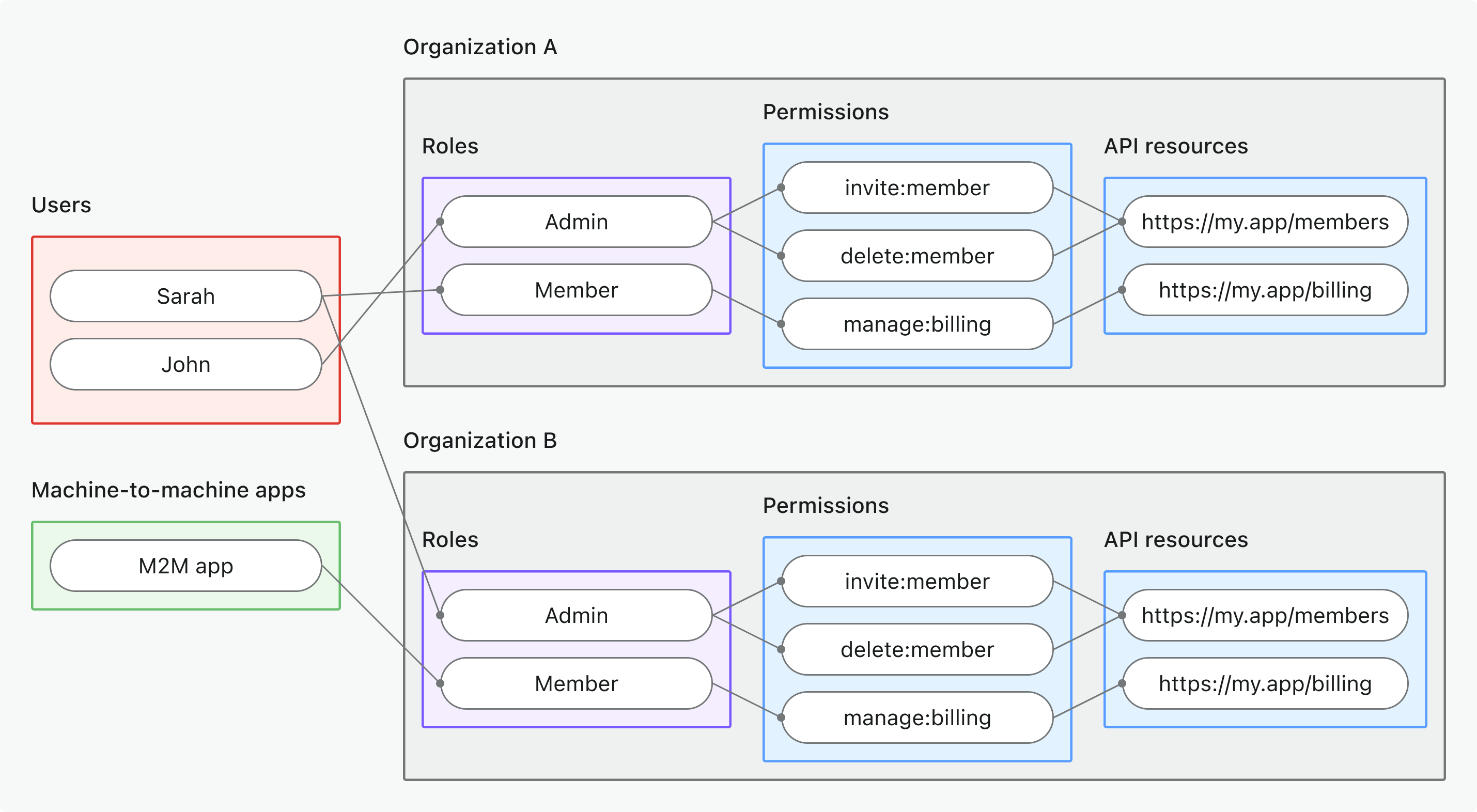使用 RBAC 與 JWT 驗證 (JWT validation) 保護你的 Sinatra API
本指南將協助你透過 角色型存取控制 (RBAC, Role-based Access Control) 以及 Logto 簽發的 JSON Web Token (JWT) 實作授權 (Authorization),以保護你的 Sinatra API。
開始前
你的用戶端應用程式需要從 Logto 取得存取權杖 (Access tokens)。如果你尚未完成用戶端整合,請參考我們針對 React、Vue、Angular 或其他前端框架的 快速入門,或伺服器對伺服器存取請參閱 機器對機器指南。
本指南聚焦於在你的 Sinatra 應用程式中,對這些權杖進行伺服器端驗證。

你將學到
- JWT 驗證: 學習如何驗證存取權杖 (Access tokens) 並擷取驗證 (Authentication) 資訊
- 中介軟體實作: 建立可重複使用的中介軟體以保護 API
- 權限模型: 理解並實作不同的授權 (Authorization) 模式:
- 全域 API 資源 (Global API resources) 用於應用程式層級端點
- 組織權限 (Organization permissions) 控制租戶專屬功能
- 組織層級 API 資源 (Organization-level API resources) 用於多租戶資料存取
- RBAC 整合: 在 API 端點強制執行角色型權限 (Role-based permissions) 與權限範圍 (Scopes)
先決條件
- 已安裝最新版穩定版 Ruby
- 基本了解 Sinatra 與 Web API 開發
- 已設定 Logto 應用程式(如有需要請參閱 快速入門)
權限 (Permission) 模型總覽
在實作保護機制前,請先選擇最適合你應用程式架構的權限模型。這與 Logto 的三大授權 (Authorization) 情境相符:
- 全域 API 資源 (Global API resources)
- 組織(非 API)權限 (Organization (non-API) permissions)
- 組織層級 API 資源 (Organization-level API resources)

- 適用情境: 保護整個應用程式共用的 API 資源(非組織專屬)
- 權杖類型: 具有全域受眾 (global audience) 的存取權杖 (Access token)
- 範例: 公開 API、核心產品服務、管理端點
- 最適用於: 所有客戶共用 API 的 SaaS 產品、無租戶隔離的微服務架構
- 深入瞭解: 保護全域 API 資源

- 適用情境: 控制組織專屬的操作、UI 功能或商業邏輯(非 API)
- 權杖類型: 具有組織專屬受眾 (organization-specific audience) 的組織權杖 (Organization token)
- 範例: 功能開關、儀表板權限、成員邀請控制
- 最適用於: 具有組織專屬功能與流程的多租戶 SaaS
- 深入瞭解: 保護組織(非 API)權限

- 適用情境: 保護僅在特定組織情境下可存取的 API 資源
- 權杖類型: 具有 API 資源受眾 (API resource audience) + 組織情境 (organization context) 的組織權杖 (Organization token)
- 範例: 多租戶 API、組織範圍資料端點、租戶專屬微服務
- 最適用於: API 資料以組織為範圍的多租戶 SaaS
- 深入瞭解: 保護組織層級 API 資源
💡 請在繼續前選擇你的模型 —— 本指南後續內容將以你選擇的方式為參考。
快速準備步驟
設定 Logto 資源與權限 (Permissions)
- 全域 API 資源 (Global API resources)
- 組織(非 API)權限 (Organization (non-API) permissions)
- 組織層級 API 資源 (Organization-level API resources)
- 建立 API 資源 (API resource): 前往 Console → API 資源 (API resources) 並註冊你的 API(例如:
https://api.yourapp.com) - 定義權限 (Permissions): 新增如
read:products、write:orders等權限範圍 (Scopes) —— 參考 定義帶有權限的 API 資源 - 建立全域角色 (Global roles): 前往 Console → 角色 (Roles) 並建立包含 API 權限的角色 —— 參考 設定全域角色
- 指派角色 (Assign roles): 將角色指派給需要 API 存取權的使用者或 M2M 應用程式
- 定義組織權限 (Organization permissions): 在組織範本中建立如
invite:member、manage:billing等非 API 組織權限 - 設定組織角色 (Organization roles): 在組織範本中配置組織專屬角色並指派權限給這些角色
- 指派組織角色 (Assign organization roles): 在每個組織情境下將使用者指派到組織角色
- 建立 API 資源 (API resource): 如上註冊你的 API 資源,但將用於組織情境
- 定義權限 (Permissions): 新增如
read:data、write:settings等限定於組織情境的權限範圍 (Scopes) - 設定組織範本 (Configure organization template): 設定包含 API 資源權限的組織角色
- 指派組織角色 (Assign organization roles): 將使用者或 M2M 應用程式指派到包含 API 權限的組織角色
- 多租戶設定 (Multi-tenant setup): 確保你的 API 能處理組織範圍的資料與驗證
建議從我們的 角色型存取控制 (RBAC) 指南 開始,獲得逐步設定說明。
更新你的用戶端應用程式
在用戶端請求適當的權限範圍 (Scopes):
- 使用者驗證 (Authentication):更新你的應用程式 → 以請求你的 API 權限範圍和/或組織情境
- 機器對機器 (M2M):設定 M2M 權限範圍 → 以進行伺服器對伺服器存取
通常需要在用戶端設定中新增以下一項或多項:
- OAuth 流程中的
scope參數 - 用於 API 資源存取的
resource參數 - 組織情境下的
organization_id
請確保你測試的使用者或 M2M 應用程式已被指派包含所需 API 權限的正確角色或組織角色。
初始化你的 API 專案
要初始化一個新的 Sinatra 專案,請建立一個目錄並設置基本結構:
mkdir your-api-name
cd your-api-name
建立一個 Gemfile:
source 'https://rubygems.org'
gem 'sinatra'
安裝相依套件:
bundle install
建立一個基本的 Sinatra 應用程式:
require 'sinatra'
require 'json'
get '/' do
content_type :json
{ message: 'Hello from Sinatra API' }.to_json
end
啟動開發伺服器:
ruby app.rb
如需更多關於如何設置路由、中介軟體及其他功能的詳細資訊,請參閱 Sinatra 官方文件。
初始化常數與工具函式
在你的程式碼中定義必要的常數與工具函式,以處理權杖(token)的擷取與驗證。一個有效的請求必須包含 Authorization 標頭,格式為 Bearer <存取權杖 (Access token)>。
module AuthConstants
JWKS_URI = 'https://your-tenant.logto.app/oidc/jwks'
ISSUER = 'https://your-tenant.logto.app/oidc'
end
class AuthInfo
attr_accessor :sub, :client_id, :organization_id, :scopes, :audience
def initialize(sub, client_id = nil, organization_id = nil, scopes = [], audience = [])
@sub = sub
@client_id = client_id
@organization_id = organization_id
@scopes = scopes
@audience = audience
end
def to_h
{
sub: @sub,
client_id: @client_id,
organization_id: @organization_id,
scopes: @scopes,
audience: @audience
}
end
end
class AuthorizationError < StandardError
attr_reader :status
def initialize(message, status = 403)
super(message)
@status = status
end
end
module AuthHelpers
def extract_bearer_token(request)
authorization = request.headers['Authorization']
raise AuthorizationError.new('Authorization header is missing', 401) unless authorization
raise AuthorizationError.new('Authorization header must start with "Bearer "', 401) unless authorization.start_with?('Bearer ')
authorization[7..-1] # 移除 'Bearer ' 前綴
end
end
取得你的 Logto 租戶資訊
你需要以下數值來驗證 Logto 發行的權杖:
- JSON Web Key Set (JWKS) URI:Logto 公鑰的網址,用於驗證 JWT 簽章。
- 簽發者 (Issuer):預期的簽發者值(Logto 的 OIDC URL)。
首先,找到你的 Logto 租戶端點。你可以在多個地方找到:
- 在 Logto Console,設定 → 網域。
- 在你於 Logto 配置過的任何應用程式設定中,設定 → 端點與憑證。
從 OpenID Connect 探索端點取得
這些數值可以從 Logto 的 OpenID Connect 探索端點取得:
https://<your-logto-endpoint>/oidc/.well-known/openid-configuration
以下為範例回應(為簡潔省略其他欄位):
{
"jwks_uri": "https://your-tenant.logto.app/oidc/jwks",
"issuer": "https://your-tenant.logto.app/oidc"
}
在程式碼中硬編碼(不建議)
由於 Logto 不允許自訂 JWKS URI 或簽發者 (Issuer),你可以將這些數值硬編碼在程式碼中。但這不建議用於正式環境,因為若未來有設定變更,可能會增加維護負擔。
- JWKS URI:
https://<your-logto-endpoint>/oidc/jwks - 簽發者 (Issuer):
https://<your-logto-endpoint>/oidc
驗證權杖與權限
在擷取權杖並取得 OIDC 設定後,請驗證以下項目:
- 簽章 (Signature): JWT 必須有效且由 Logto(透過 JWKS)簽署。
- 簽發者 (Issuer): 必須符合你的 Logto 租戶簽發者。
- 受眾 (Audience): 必須符合在 Logto 註冊的 API 資源標示符 (resource indicator),或在適用時符合組織 (Organization) 上下文。
- 過期時間 (Expiration): 權杖不得過期。
- 權限範圍 (Permissions, scopes): 權杖必須包含 API/操作所需的權限範圍 (scopes)。scopes 會以空格分隔字串出現在
scope宣告 (claim) 中。 - 組織 (Organization) 上下文: 若保護的是組織層級 API 資源,需驗證
organization_id宣告 (claim)。
詳情請參閱 JSON Web Token 以瞭解 JWT 結構與宣告 (claims)。
各權限模型需檢查的項目
不同權限模型下,宣告 (claims) 與驗證規則有所不同:
- 全域 API 資源
- 組織(非 API)權限
- 組織層級 API 資源
- 受眾宣告 (
aud): API 資源標示符 (API resource indicator) - 組織宣告 (
organization_id): 不存在 - 權限範圍需檢查 (
scope): API 資源權限 (API resource permissions)
- 受眾宣告 (
aud):urn:logto:organization:<id>(組織上下文於aud宣告中) - 組織宣告 (
organization_id): 不存在 - 權限範圍需檢查 (
scope): 組織權限 (Organization permissions)
- 受眾宣告 (
aud): API 資源標示符 (API resource indicator) - 組織宣告 (
organization_id): 組織 ID(必須與請求相符) - 權限範圍需檢查 (
scope): API 資源權限 (API resource permissions)
對於非 API 組織權限,組織上下文由 aud 宣告表示 (例如
urn:logto:organization:abc123)。organization_id 宣告僅存在於組織層級 API 資源權杖中。
對於多租戶 API,務必同時驗證權限範圍 (scopes) 及上下文(受眾 (audience)、組織 (organization)),以確保安全。
新增驗證邏輯
我們使用 jwt gem 來驗證 JWT。請將其加入你的 Gemfile:
gem 'jwt'
# net-http 自 Ruby 2.7 起已是標準函式庫,無需額外加入
然後執行:
bundle install
首先,新增這些共用工具來處理 JWKS 與權杖驗證:
require 'jwt'
require 'net/http'
require 'json'
class JwtValidator
include AuthHelpers
def self.fetch_jwks
@jwks ||= begin
uri = URI(AuthConstants::JWKS_URI)
response = Net::HTTP.get_response(uri)
raise AuthorizationError.new('Failed to fetch JWKS', 401) unless response.is_a?(Net::HTTPSuccess)
jwks_data = JSON.parse(response.body)
JWT::JWK::Set.new(jwks_data)
end
end
def self.validate_jwt(token)
jwks = fetch_jwks
# 讓 JWT 函式庫自 JWKS 偵測演算法
decoded_token = JWT.decode(token, nil, true, {
iss: AuthConstants::ISSUER,
verify_iss: true,
verify_aud: false, # 依據權限模型手動驗證 audience
jwks: jwks
})[0]
verify_payload(decoded_token)
decoded_token
end
def self.create_auth_info(payload)
scopes = payload['scope']&.split(' ') || []
audience = payload['aud'] || []
AuthInfo.new(
payload['sub'],
payload['client_id'],
payload['organization_id'],
scopes,
audience
)
end
def self.verify_payload(payload)
# 根據權限模型實作驗證邏輯
# 相關內容將於下方權限模型區段說明
end
end
接著,實作中介軟體以驗證存取權杖 (Access token):
class AuthMiddleware
include AuthHelpers
def initialize(app)
@app = app
end
def call(env)
request = Rack::Request.new(env)
# 僅保護特定路由
if request.path.start_with?('/api/protected')
begin
token = extract_bearer_token(request)
decoded_token = JwtValidator.validate_jwt(token)
# 將驗證資訊存入 env 以便通用使用
env['auth'] = JwtValidator.create_auth_info(decoded_token)
rescue AuthorizationError => e
return [e.status, { 'Content-Type' => 'application/json' }, [{ error: e.message }.to_json]]
rescue JWT::DecodeError, JWT::VerificationError, JWT::ExpiredSignature => e
return [401, { 'Content-Type' => 'application/json' }, [{ error: 'Invalid token' }.to_json]]
end
end
@app.call(env)
end
end
根據你的權限模型,在 JwtValidator 中實作相應的驗證邏輯:
- 全域 API 資源 (Global API resources)
- 組織(非 API)權限 (Organization (non-API) permissions)
- 組織層級 API 資源 (Organization-level API resources)
def self.verify_payload(payload)
# 檢查 audience 宣告是否符合你的 API 資源標示符
audiences = payload['aud'] || []
unless audiences.include?('https://your-api-resource-indicator')
raise AuthorizationError.new('Invalid audience')
end
# 檢查全域 API 資源所需的權限範圍 (Scopes)
required_scopes = ['api:read', 'api:write'] # 請替換為實際所需權限範圍
token_scopes = payload['scope']&.split(' ') || []
unless required_scopes.all? { |scope| token_scopes.include?(scope) }
raise AuthorizationError.new('Insufficient scope')
end
end
def self.verify_payload(payload)
# 檢查 audience 宣告是否符合組織格式
audiences = payload['aud'] || []
has_org_audience = audiences.any? { |aud| aud.start_with?('urn:logto:organization:') }
unless has_org_audience
raise AuthorizationError.new('Invalid audience for organization permissions')
end
# 檢查組織 ID 是否與情境相符(你可能需要從請求內容取得)
expected_org_id = 'your-organization-id' # 從請求內容取得
expected_aud = "urn:logto:organization:#{expected_org_id}"
unless audiences.include?(expected_aud)
raise AuthorizationError.new('Organization ID mismatch')
end
# 檢查所需組織權限範圍
required_scopes = ['invite:users', 'manage:settings'] # 請替換為實際所需權限範圍
token_scopes = payload['scope']&.split(' ') || []
unless required_scopes.all? { |scope| token_scopes.include?(scope) }
raise AuthorizationError.new('Insufficient organization scope')
end
end
def self.verify_payload(payload)
# 檢查 audience 宣告是否符合你的 API 資源標示符
audiences = payload['aud'] || []
unless audiences.include?('https://your-api-resource-indicator')
raise AuthorizationError.new('Invalid audience for organization-level API resources')
end
# 檢查組織 ID 是否與情境相符(你可能需要從請求內容取得)
expected_org_id = 'your-organization-id' # 從請求內容取得
org_id = payload['organization_id']
unless expected_org_id == org_id
raise AuthorizationError.new('Organization ID mismatch')
end
# 檢查組織層級 API 資源所需的權限範圍
required_scopes = ['api:read', 'api:write'] # 請替換為實際所需權限範圍
token_scopes = payload['scope']&.split(' ') || []
unless required_scopes.all? { |scope| token_scopes.include?(scope) }
raise AuthorizationError.new('Insufficient organization-level API scopes')
end
end
套用中介軟體至你的 API
現在,將中介軟體套用到你受保護的 API 路由。
require 'sinatra'
require 'json'
require_relative 'auth_middleware'
require_relative 'auth_constants'
require_relative 'auth_info'
require_relative 'authorization_error'
require_relative 'auth_helpers'
require_relative 'jwt_validator'
# 套用中介軟體 (middleware)
use AuthMiddleware
get '/api/protected' do
content_type :json
# 從 env 取得驗證 (Authentication) 資訊
auth = env['auth']
{ auth: auth.to_h }.to_json
end
# 公開端點(未經中介軟體保護)
get '/' do
content_type :json
{ message: "Public endpoint" }.to_json
end
測試你的受保護 API
取得存取權杖 (Access tokens)
從你的用戶端應用程式取得: 如果你已完成用戶端整合,你的應用程式可以自動取得權杖。擷取存取權杖 (Access token) 並在 API 請求中使用。
使用 curl / Postman 測試:
-
使用者權杖 (User tokens): 使用你的用戶端應用程式的開發者工具,從 localStorage 或網路分頁複製存取權杖 (Access token)
-
機器對機器權杖 (Machine-to-machine tokens): 使用 client credentials flow。以下是使用 curl 的非標準範例:
curl -X POST https://your-tenant.logto.app/oidc/token \
-H "Content-Type: application/x-www-form-urlencoded" \
-d "grant_type=client_credentials" \
-d "client_id=your-m2m-client-id" \
-d "client_secret=your-m2m-client-secret" \
-d "resource=https://your-api-resource-indicator" \
-d "scope=api:read api:write"你可能需要根據你的 API 資源 (API resource) 和權限 (Permissions) 調整
resource和scope參數;如果你的 API 以組織 (Organization) 為範圍,也可能需要organization_id參數。
需要檢查權杖內容嗎?請使用我們的 JWT 解碼工具 來解碼並驗證你的 JWT。
測試受保護端點
有效權杖請求
curl -H "Authorization: Bearer eyJhbGciOiJSUzI1NiIsInR5cCI6IkpXVCJ9..." \
http://localhost:3000/api/protected
預期回應:
{
"auth": {
"sub": "user123",
"clientId": "app456",
"organizationId": "org789",
"scopes": ["api:read", "api:write"],
"audience": ["https://your-api-resource-indicator"]
}
}
缺少權杖
curl http://localhost:3000/api/protected
預期回應 (401):
{
"error": "Authorization header is missing"
}
無效權杖
curl -H "Authorization: Bearer invalid-token" \
http://localhost:3000/api/protected
預期回應 (401):
{
"error": "Invalid token"
}
權限模型專屬測試
- 全域 API 資源 (Global API resources)
- 組織(非 API)權限 (Organization (non-API) permissions)
- 組織層級 API 資源 (Organization-level API resources)
針對以全域權限範圍 (Scopes) 保護的 API 測試情境:
- 有效權限範圍 (Valid scopes): 使用包含所需 API 權限範圍(如
api:read、api:write)的權杖測試 - 缺少權限範圍 (Missing scopes): 權杖缺少必要權限範圍時,預期回傳 403 Forbidden
- 錯誤受眾 (Wrong audience): 權杖受眾 (Audience) 不符合 API 資源時,預期回傳 403 Forbidden
# 權杖缺少必要權限範圍 - 預期 403
curl -H "Authorization: Bearer token-without-required-scopes" \
http://localhost:3000/api/protected
針對組織專屬存取控制的測試情境:
- 有效組織權杖 (Valid organization token): 使用包含正確組織 (Organization) 資訊(組織 ID 與權限範圍)的權杖測試
- 缺少權限範圍 (Missing scopes): 使用者沒有執行請求操作的權限時,預期回傳 403 Forbidden
- 錯誤組織 (Wrong organization): 權杖受眾 (Audience) 不符合組織上下文(
urn:logto:organization:<organization_id>)時,預期回傳 403 Forbidden
# 錯誤組織的權杖 - 預期 403
curl -H "Authorization: Bearer token-for-different-organization" \
http://localhost:3000/api/protected
結合 API 資源驗證與組織上下文的測試情境:
- 有效組織 + API 權限範圍 (Valid organization + API scopes): 權杖同時具備組織上下文與所需 API 權限範圍時測試
- 缺少 API 權限範圍 (Missing API scopes): 組織權杖缺少必要 API 權限時,預期回傳 403 Forbidden
- 錯誤組織 (Wrong organization): 使用不同組織的權杖存取 API 時,預期回傳 403 Forbidden
- 錯誤受眾 (Wrong audience): 權杖受眾 (Audience) 不符合組織層級 API 資源時,預期回傳 403 Forbidden
# 組織權杖缺少 API 權限範圍 - 預期 403
curl -H "Authorization: Bearer organization-token-without-api-scopes" \
http://localhost:3000/api/protected
延伸閱讀
RBAC 實務應用:為你的應用程式實現安全授權 (Authorization)
建立多租戶 SaaS 應用程式:從設計到實作的完整指南